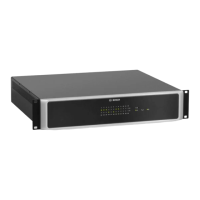PAVIRO Router Connection | en 17
Bosch Security Systems, B.V.
User manual
2022-11 | 07 | F01U306901
Pin Designation Cable color
T568A T568B
2 CAN_GND Green Orange
4 CAN_H (+) Blue
5 CAN_L (-) Blue stripes
Table6.2: Assignment of the CAN BUS interface
Cable specification
In accordance with the ISO 11898-2 standard, shielded twisted-pair cables with an impedance
of 120ohms must be used as the data transfer cable for the CAN bus. A terminating resistance
of 120ohms must be provided at both ends as the cable terminator. The maximum bus length
depends on the data transmission rate, the type of data transmission cable, and the number
of bus participants.
Recommended connecting cable: shielded twisted-pair, CAT5, 100 / 120Ω.
Bus length (in
m)
Data transmission cable Termination (in
Ω)
Maximum data
transmission
rate
Resistance per unit
(in mΩ/m)
Cable cross-
section
0 to 40 < 70 0.25 to 0.34mm²
AWG23, AWG22
124 1000 kbit/s at
40 m
40 to 300 < 60 0.34 to 0.6 mm²
AWG22, AWG20
127 500 kbit/s at
100 m
300 to 600 < 40 0.5 to 0.6 mm²
AWG20
150 to 300 100 kbit/s at
500 m
600 to 1000 < 26 0.75 to 0.8 mm²
AWG18
150 to 300 62.5 kbit/s at
1000 m
Table6.3: Relationships for CAN networks with up to 64 participants
If there are long cables and several devices on the CAN bus, terminating resistors with ohm
ratings higher than the specified 120ohms are recommended in order to reduce the resistive
load for the interface drivers, which in turn reduces the voltage loss from one cable end to
another.
The following table allows initial estimates for the required cable cross-section for different
bus lengths and various numbers of bus participants.
Bus length (in m) Number of devices on the CAN Bus
32 64 100
100 0.25 mm² or AWG24 0.34 mm² or AWG22 0.34 mm² or AWG22
250 0.34 mm² or AWG22 0.5 mm² or AWG20 0.5 mm² or AWG20
500 0.75 mm² or AWG18 0.75 mm² or AWG18 1.0 mm² or AWG17
Table6.4: CAN BUS cable cross-section
If a participant cannot be directly connected to the CAN bus, a stub line (branch line) must be
used. Since there must always be precisely two terminating resistors on a CAN bus, a stub line
cannot be terminated. This creates reflections, which impair the rest of the bus system. To

